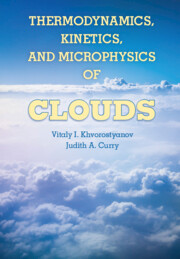Book contents
- Frontmatter
- Contents
- Preface
- 1 Introduction
- 2 Clouds and Their Properties
- 3 Thermodynamic Relations
- 4 Properties of Water and Aqueous Solutions
- 5 Diffusion and Coagulation Growth of Drops and Crystals
- 6 Wet Aerosol Processes
- 7 Activation of Cloud Condensation Nuclei into Cloud Drops
- 8 Homogeneous Nucleation
- 9 Heterogeneous Nucleation of Drops and Ice Crystals
- 10 Parameterizations of Heterogeneous Ice Nucleation
- 11. Deliquescence and Efflorescence in Atmospheric Aerosols
- 12 Terminal Velocities of Drops and Crystals
- 13 Broad Size Spectra in Clouds and the Theory of Stochastic Condensation
- 14 Analytical Solutions to the Stochastic Kinetic Equation for Precipitating Clouds
- References
- Notations
- Index
8 - Homogeneous Nucleation
Published online by Cambridge University Press: 05 September 2014
- Frontmatter
- Contents
- Preface
- 1 Introduction
- 2 Clouds and Their Properties
- 3 Thermodynamic Relations
- 4 Properties of Water and Aqueous Solutions
- 5 Diffusion and Coagulation Growth of Drops and Crystals
- 6 Wet Aerosol Processes
- 7 Activation of Cloud Condensation Nuclei into Cloud Drops
- 8 Homogeneous Nucleation
- 9 Heterogeneous Nucleation of Drops and Ice Crystals
- 10 Parameterizations of Heterogeneous Ice Nucleation
- 11. Deliquescence and Efflorescence in Atmospheric Aerosols
- 12 Terminal Velocities of Drops and Crystals
- 13 Broad Size Spectra in Clouds and the Theory of Stochastic Condensation
- 14 Analytical Solutions to the Stochastic Kinetic Equation for Precipitating Clouds
- References
- Notations
- Index
Summary
Phase transitions in a substance may proceed with or without the presence of foreign substances. If formation (nucleation) of a new phase in the original phase is catalyzed by a foreign substance, this process is called heterogeneous nucleation. IIn this chapter, we consider phase transitions without participation of a foreign substance. Formation of a new phase within the original phase under such conditions is termed homogeneous nucleation. The most important examples of homogeneous nucleation for cloud physics are: formation of ice crystals (homogeneous ice nucleation) or liquid drops from supersaturated water vapor (homogeneous drop nucleation); formation of ice crystals by the freezing of liquid water or solution drops (homogeneous freezing); and formation of drops by the melting of ice crystals.
In Chapters 3 and 4, we discussed phase transitions and conditions of equilibrium between various phases. However, a phase transition from a metastable phase A into a stable phase B does not occur instantaneously or exactly at equilibrium. A bulk phase A of some substance may exist during a sufficient time in a metastable state; that is, not in thermodynamic equilibrium, but still without transition into a more stable phase B. Examples of relevance to water are: a) supersaturated vapor (phase A) at a relative humidity greater than 100% but still without condensation into the bulk liquid water (phase B); b) superheated liquid water (phase A) above the boiling point without full transition into the vapor (phase B); c) supercooled liquid water at temperatures below the freezing point (phase A) without freezing into ice (phase B); and d) a salt solution (phase A) supersaturated with respect to dissolved salt but without crystallizing salt into a solid (phase B).
- Type
- Chapter
- Information
- Thermodynamics, Kinetics, and Microphysics of Clouds , pp. 289 - 394Publisher: Cambridge University PressPrint publication year: 2014



